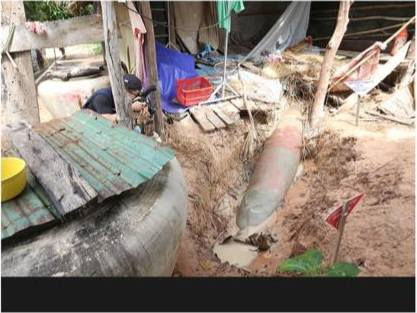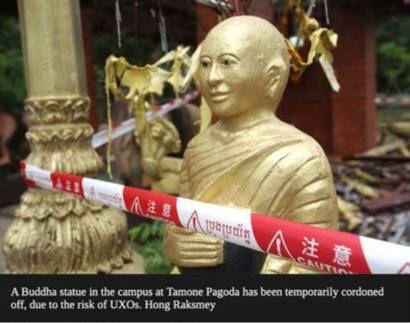CMAC warn years of UXO clearance work remains after border conflict NATIONAL
- Cambodia Embassy in Bulgaria
- Sep 2
- 4 min read
The Cambodia Mine Action Centre (CMAC) has reiterated that Thai forces used cluster munitions and dropped some of the largest conventional bombs in existence during the July 24–28 border clashes.
The border conflict as left thousands of Cambodian villagers living under the shadow of unexploded ordnance that could take years to clear.
Speaking to a group of domestic and international journalists visiting the affected areas in Oddar Meanchey and Banteay Meanchey provinces on August 29, CMAC director-general Heng Ratana said the extent of contamination is “unprecedented” in recent years.
“We’ve already found 20 unexploded bombs, and more than 1,500 remain,” he said.
“The clearance operation will take years. Unexploded bombs don’t choose their victims. They will remain a danger for years unless we remove them,” he added.
CMAC estimates that at least 1,549 bombs were dropped in Oddar Meanchey alone during the five days of fighting. Heavy machinery is now being deployed to protect deminers as hidden explosives continue to endanger farmers and children in border villages.
“This is not just a military issue — it is a humanitarian crisis,” Ratana warned.
“Cluster submunitions are scattered in farmland, forests and near schools. Even walking to collect firewood can become deadly,” he continued.
A long legacy of bombs and mines
Cambodia has been living with the deadly legacy of war for more than five decades.
From 1970 to 1975, over 539,000 tonnes of bombs were dropped on Cambodian soil during the Indochina war.
Between 1975 and 1979, the Khmer Rouge regime laid mines extensively, turning the country into what survivors call a “prison without walls”.
Guerrilla warfare after 1979 and the K5 conscription programme, or “Bamboo Curtain” in 1985 saw millions more mines laid along the Thai border.
Even after the 1993 elections, mines continued to be used by both government and resistance forces.
“Of our 835 kilometres of shared border with Thailand, around 700 kilometres are still uncleared,” Ratana explained.
“Cambodia had between four to six million landmines planted during the war from 1970 to 1998, within 28 years of war. We have cleared more than 70 per cent in the past 33 years, but millions remain,” he noted.
Since 1992, CMAC has cleared 1.2 million landmines and destroyed 2.5 million explosive remnants of war (ERWs).
“In its operations, CMAC has destroyed more than 596,000 mines — mostly anti-personnel — along with 2.5 million ERWs, such as aerial bombs, cluster munitions and UXOs,” according to CMAC.
The agency has responded to over 124,000 community requests for clearance and intervention.
Yet, more than 1,800 square kilometres remain contaminated as of January 2024, predominantly clustered along the border.
The bombs of July
Ratana revealed that Thai forces used munitions from the MK family of bombs, including the massive MK-84, each weighing nearly one tonne, with 500 kilogrammes of explosives.
“That’s a big bomb,” he said. “We also identified cluster submunitions, rockets, and smoke projectiles scattered across civilian and farming areas. Even temples such as Preah Vihear, Ta Mon Thom and Ta Krabey were affected.”
Although Cambodia is not a member of the international ban on cluster munitions, Ratana emphasized that “Cambodia has never used cluster bombs. Thailand used them, and that’s the reality”.
“We have already explained our position to the international community, including the Ottawa Convention and the UN,” he added.
CMAC has identified two main types of sub-munitions used: the M-46, which disperses 56 bomblets, and the M-85, which carries up to 45 larger explosives.
Ratana explained that one projectile alone can contaminate at least four hectares of land. The immediate area of effect covers 1.2 hectares.
The human cost
Behind the statistics are lives forever changed. Mao Sopheap, born in a refugee camp in 1979, returned to Battambang in the 1990s only to lose her right leg to a landmine in 1995 while farming.
A mother of six, she struggles to provide for her children on less than one dollar a day.
“When I go to the farm and forest, I leave my youngest son and other five children with my elder daughter to take care of them,” she said.
In Oddar Meanchey this year, a 24-year-old tractor driver, Hem Kao, was seriously injured when his vehicle hit a landmine while ploughing.
The victim resides in Thlat commune’s Svay Chek village, in Anlong Veng district and his tractor was destroyed in the blast.
The incident occurred while he was ploughing a field in Trapaing Prasat district.
The authorities have continued to urge citizens to avoid entering areas with unclear histories and to consult local authorities before accessing such areas.
The Cambodian Mine Action and Victim Assistance Authority (CMAA) noted that, including this case, there have been 17 casualties in 2025 so far — 5 fatalities and the rest injured, with some victims losing limbs. This represents a 24% decrease compared to 2024.
From January to May 2025, Cambodia recorded 20 casualties involving landmines and ERWs — 8 linked to landmines and 12 to other explosives.
Among these, six people were killed, two suffered amputations and 12 others were also injured. Notably, five boys and one girl under 18 were among the victims.
Years to go
Despite three decades of clearance, Cambodia’s battle against landmines and unexploded ordnance is far from over.
Ratana acknowledged that progress has been made but stressed that international support remains vital.
“Every bomb we remove is a life saved,” he said.
“But with millions still buried, and now new bombs added from the recent fighting, Cambodia will continue to face this danger for years to come,” he warned.











Comments